Industrial automation, like most advances, arises from a need: the need to improve the manual process of performing physical or mechanical activities of great difficulty, whether due to their danger, productivity, or need for perfection.
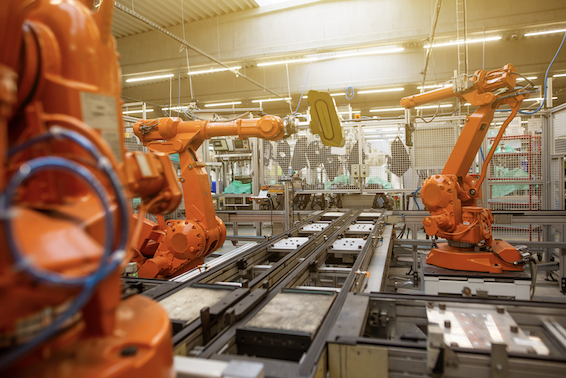
The use of this technology positively affects both the profitability and productivity of the company, as well as the improvement of the quality of work and the conditions of the employees, also going through factors as valued and necessary as sustainability or the improvement of energetic efficiency.
There are more and more companies in the industrial field that are committed to automation. In this post we will address 7 trends that are revolutionizing the market and the most active startups within them, which we have detected using Linknovate platform. This work has been led in collaboration with tech expo Advanced Factories.
Industrial Internet of Things (IIoT)
The Industrial Internet of Things (IIoT) is the set of autonomous sensors, instruments and devices connected via the Internet to industrial applications. The main objective of its application is to increase safety and efficiency in production centers.
The IIoT helps manufacturers connect and monitor the various components of their operations, gaining insight that weren’t attainable before. This connectivity provides manufacturers with valuable data that allows them to change, optimize and improve every facet of their manufacturing process.

Current IIoT applications are mainly concentrated in the sectors of manufacturing, transports and energy, with a global investment that exceeds $300.000M and is expected to double in 2025. SMEs (small and medium-sized enterprises) and startups represent the most active entities in innovation in this market, as shown in the graph above.
Today, IIoT applications are important for large-scale manufacturing processes. They help to find any failure in the connected devices, such as sensors, sensor communication, networks, microphones, cameras, etc. These numerous benefits are what made it one of the biggest drivers of productivity and innovation in global industrial production.
This evolution can be seen in the graph below, where a positive evolution of the trend can be observed over the years, especially in recent years.
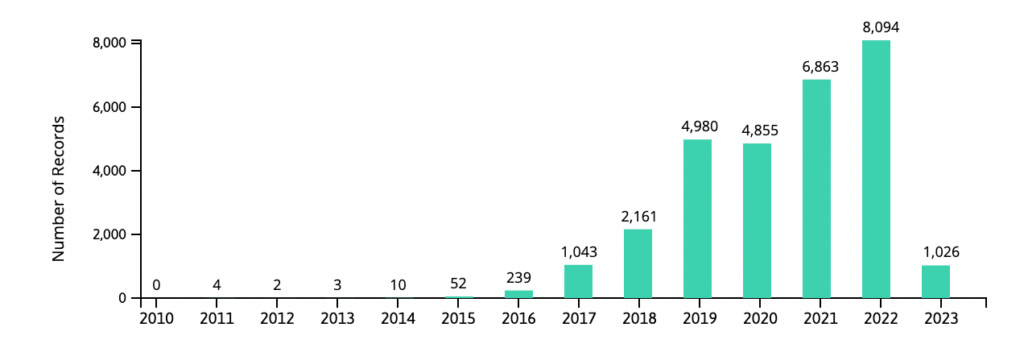
Among the startups that provide IIoT solutions for various industrial sectors, the following stand out:
Astrocast was founded in 2014 by the developers of Swiss Cube, one of the longest-lived operational nanosatellites in space. Its objective, together with the collaboration of the European Space Agency, Airbus and Thuraya, is to develop a global network of nanosatellites for the Internet of Things (IoT). Airbus and Astrocast have developed an ASIC and low cost module that provides the most energy efficient satellite modem for IoT applications.
Link Labs offers a comprehensive enterprise IoT platform for tagging, locating, and monitoring equipment, supplies, and assets. Its solutions are applicable to any level of the manufacturing chain, as well as the supply chain. The company has more than 25 patents for its innovative solutions.
Litmus Automation is backed by Google Cloud, Dell Technologies, HPE, Hitachi, Mitsubishi and other Fortune 500 companies, and have recently raised a $30M Series B round.
Its data platform unifies device connectivity, collects data from any industrial asset, integrates data with any cloud or internal business system, and offers pre-defined key performance indicators (KPIs) and analytics.
Predictive Maintenance
Powered by IoT, AI and machine learning, predictive maintenance helps manufacturers prevent downtime by detecting problems before they arise.
The benefits of incorporating predictive maintenance technology into manufacturing operations range from saving maintenance costs to extending the expected life of machinery. The following graph clearly indicates how plant predictive maintenance applications represent the biggest trend in the research and development of this technology. McKinsey & Company predicts that predictive maintenance programs will reduce maintenance costs by 20% and unplanned downtime by 50%.
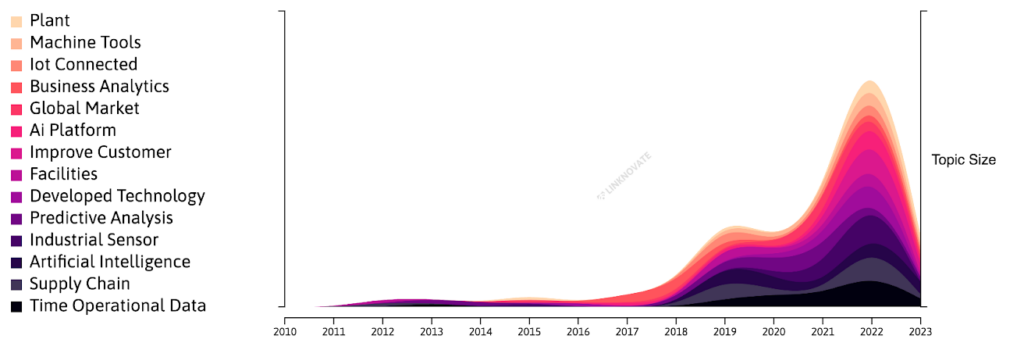
Some exemplary startups in the field are:
Asystom: French startup that offers a complete predictive maintenance solution, from measurement to visualization, including analysis and secure data transmission. This solution allows you to monitor all the components of a system, get real-time alerts about the status of each monitored machine and, thanks to the integrated intelligence, predict potential failures, drifts and anomalies.
Machine Sense: Its technology focuses on predictive maintenance and analysis of industrial machinery, components and infrastructure systems (pumps, compressors and electrical supply). They solve the day-to-day problems of process manufacturers, not only insufficient preventive maintenance, but also the electrical inconsistencies that plague intelligent machines.
Collaborative robots (CoBots)
Known as CoBots, these robots help to improve the general efficiency in the workplace, since they carry out tasks inaccessible to industrial robots and help humans in tasks that are too repetitive, heavy or dangerous: their interaction with the operators is essential, and for this reason they are named “collaborative”.
Autonomous mobile robots (AMRs) are uniquely suited to this collaboration work, as they can be programmed to consistently perform non-value-added jobs, such as moving heavy goods, allowing people to focus on skilled work.
The application and development of this technology has started to leave the academic environment and enter the market considerably in the last eight years, and it is maintaining a positive trend also thanks to a strong presence of SMEs and startups in the sector.

TechMan Robot is a leading company in vision technology and collaborative robotics. TM Robot is equipped with a built-in vision system, which is integrated in both hardware and software, compared to add-on vision for robotics, which is more time-consuming and expensive to implement.
The company is a provider of various solutions, including editing software,TMflow™, which allows you to program your own CoBot projects without any coding.
Productive Robotics is an American 7-axis collaborative robotic arm industrial robot company. Its goal is easy programming through OB7. The CoBot is taught via physical demonstration, making it easy for operators and existing staff to set up jobs without prior coding or programming experience.
Founded in Copenhagen (Denmark), Kassow Robots develops and manufactures lightweight and efficient collaborative robots for industrial applications. Their motto is “strong, fast, simple”. The ease of use of Kassow Robots gives companies greater flexibility, without having to rely on robotics specialists to perform complex programming and automation. In addition, their CoBots are compact enough to be used in tight spaces.
Computer vision / image analysis
The applications of digital vision and image analysis based on Deep Learning algorithms have become useful tools for the automation of plant processes, and in particular in the inspection part, where their efficiency exceeds both operators humans and traditional artificial vision systems. The research and development of this technology applied to the industrial sector has grown considerably in the last five years, and it can be predicted that it will continue to maintain a positive trend in 2023.

Computer vision and image analysis in industrial applications, thematic evolution by year, source: Linknovate
The computer vision image analysis service can extract a wide variety of visual characteristics from images, and is applied in numerous industries beyond manufacturing. You can determine, for example, if an image contains adult content, find specific brands or objects, or find human faces.
PerkinElmer informatics transforms data into actionable information. It is an enterprise-class visual analytics and discovery platform, enabling organizations to easily mine scientific data and gain insights for real-time data-driven decision-making.
Headwall Photonics® started with diffractive optics and the unique ability to collect and manage reflected light, to become the leading provider of high-performance spectral acquisition instruments and exploitation software.
Arcturus offers Brinq, a comprehensive vision-based approach to creating real-time analytics at the edge. It is a set of solutions that combine a microservices architecture, powerful vision algorithms, optimized inference, full-stack integration, and edge hardware.
Robots-as-a-Service (RaaS)
Robots as a Service (RaaS) describes the use of robots by renting out robotic devices on an as-needed basis, as opposed to the traditional method of direct trading.
“Robot rental” solutions are cloud-based, allowing robots to be easily accessed and used when and where they are needed for any period of time, creating greater flexibility for manufacturing operations and potential cost savings.
The RaaS concept comes to change the situation of small and medium-sized manufacturers that have not been so quick to adopt robotic automation due to high costs. As the following graph shows, the sector is led by the US, followed by Japan and Germany.
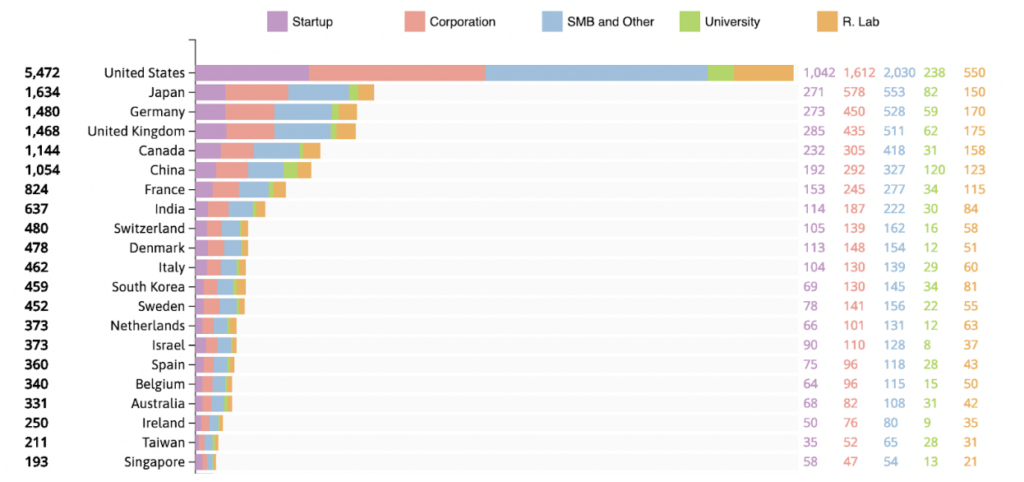
inVia Robotics works with machine precision under a RaaS model, and they have created a flexible and agile approach that revitalizes warehouses, using automation to break deadlock with a focus on e-commerce.
Cobalt Robotics automates important but repetitive tasks such as alarm response, vendor escort, and roving audits. Its services help keep the business going during emergencies, keep employees safe in the workplace, and protect their intellectual property.
Knightscope offers Autonomous Safety Robots (ASR). They use a unique combination of autonomous driving technology, robotics, artificial intelligence (AI) and electric “vehicles”. Their tech can be adopted in multiple locations at once, giving businesses additional eyes, ears and voice on the ground.
AI-based cybersecurity
Cybersecurity has become one of the main problems of process automation. Digitization, increased convergence, and the integration of operational technology and information technology are finding new avenues for cyberattacks. Due to the increasing number of cyberattack incidents, the need for cybersecurity in automation has increased.

Veriti has extensive experience in both cyber attack and cyber defense, and has created a unified security posture management platform. Veriti proactively identifies and fixes security breaches.
Cerby is an access management platform for non-federated applications. Non-federated applications are the most common type of corporate application (6 out of 10) and are also the most common entry point for threat actors (exploited in two out of three cyber incidents).
Cerby eliminates the need for manual tools like enterprise password managers and reduces the compliance burden associated with manual management of non-federated applications. It does this by introducing each non-federated application into the existing workforce platform identity lifecycle.
Robotic Process Automation (RPA)
70% of deterministic, manual and repetitive operations can be automated using RPA bots. This application represents a general trend in industrial automation, encompassing three relevant technologies: Robotic Process Automation software (RPA), Cognitive Technology, and Artificial Intelligence.
Thanks to RPA, various repetitive operations of business applications can be automated. RPA and AI integrate to build more sophisticated automation, providing the self-healing and context needed for the automated process.
RPA helps increase employee productivity, freeing workers from repetitive and time-consuming operations, and its adoption will likely accelerate the effectiveness of Industry 4.0 throughout the value chain.
We can observe in the following graph that the evolution of this trend has been increasing over the years, standing out in 2022.
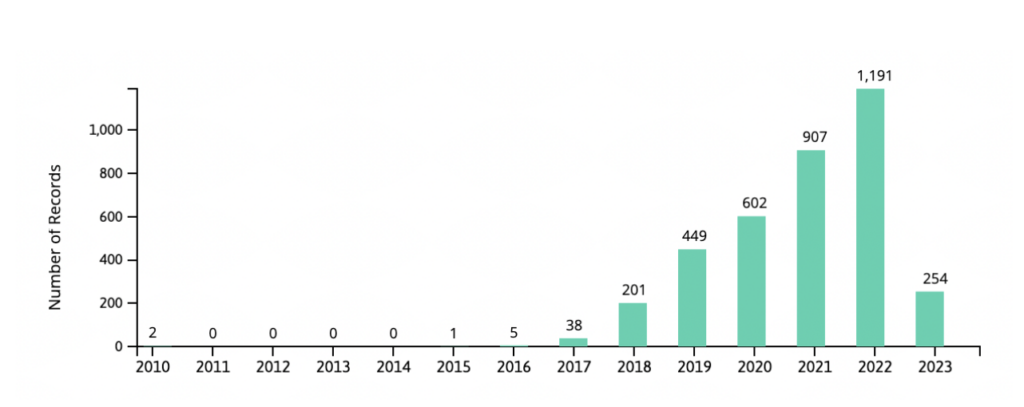
Formant partners with experts in software, hardware, AI, cloud, robotics, logistics experts, and other world-class operators in an effort to build an ecosystem that powers the next generation of robotics. Their tech allows users to manage and control autonomous devices from anywhere in the world with a low latency direct connection, joystick, direct commands or SSH without VPN.
Humatics creates accurate location and navigation data to support multiple use cases in manufacturing, transportation, robotics, surgery, and more. It works with digital train positioning, increasing transit system capacity and improving overall system availability to reduce interruptions, increase the number of users and improve overall system uptime.
Ready Robotics eliminates the risks and challenges of implementing automation. It offers the ability to schedule and manage work from a single, easy-to-use interface. Its ForgeOS programming language makes it easy for companies to control and program the most popular brands of robots from a single, easy-to-use interface.





